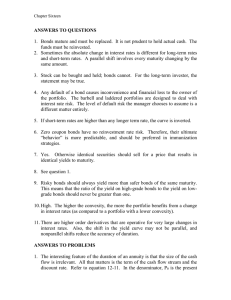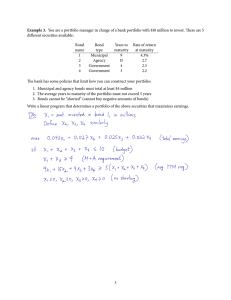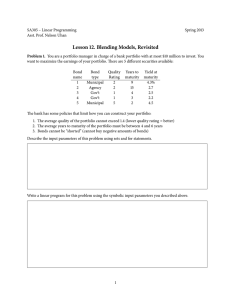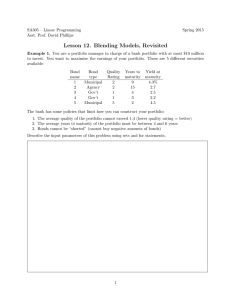Chapter Fourteen Revision of the Fixed-Income Portfolio KEY POINTS
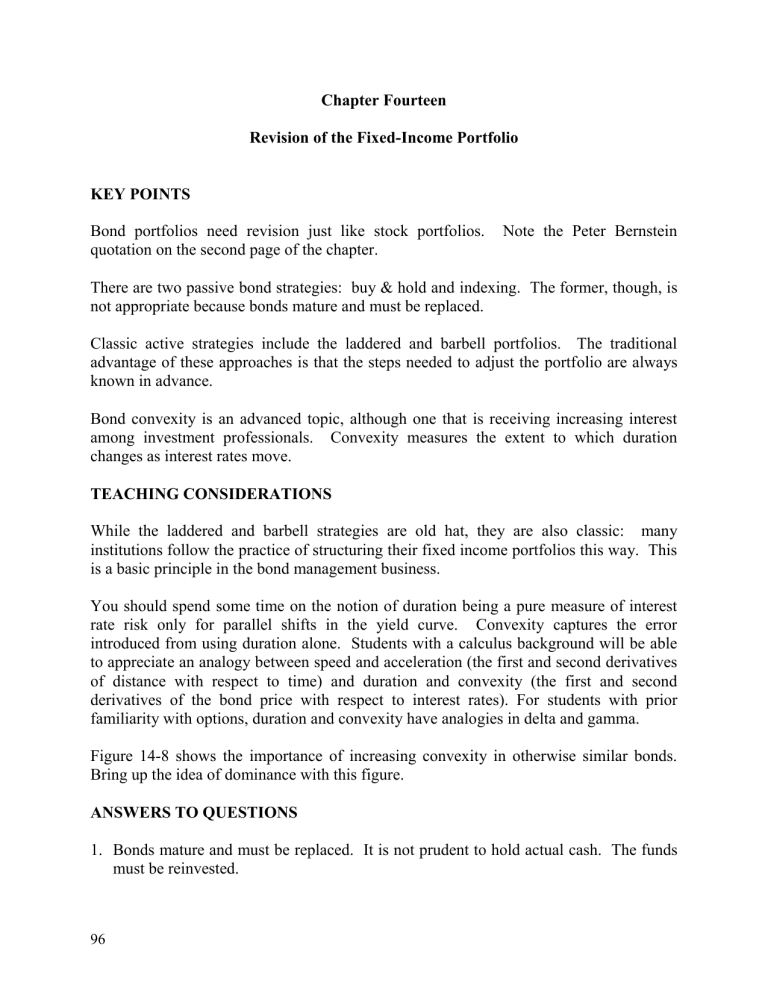
Chapter Fourteen
Revision of the Fixed-Income Portfolio
KEY POINTS
Bond portfolios need revision just like stock portfolios. Note the Peter Bernstein quotation on the second page of the chapter.
There are two passive bond strategies: buy & hold and indexing. The former, though, is not appropriate because bonds mature and must be replaced.
Classic active strategies include the laddered and barbell portfolios. The traditional advantage of these approaches is that the steps needed to adjust the portfolio are always known in advance.
Bond convexity is an advanced topic, although one that is receiving increasing interest among investment professionals. Convexity measures the extent to which duration changes as interest rates move.
TEACHING CONSIDERATIONS
While the laddered and barbell strategies are old hat, they are also classic: many institutions follow the practice of structuring their fixed income portfolios this way. This is a basic principle in the bond management business.
You should spend some time on the notion of duration being a pure measure of interest rate risk only for parallel shifts in the yield curve. Convexity captures the error introduced from using duration alone. Students with a calculus background will be able to appreciate an analogy between speed and acceleration (the first and second derivatives of distance with respect to time) and duration and convexity (the first and second derivatives of the bond price with respect to interest rates). For students with prior familiarity with options, duration and convexity have analogies in delta and gamma.
Figure 14-8 shows the importance of increasing convexity in otherwise similar bonds.
Bring up the idea of dominance with this figure.
ANSWERS TO QUESTIONS
1.
Bonds mature and must be replaced. It is not prudent to hold actual cash. The funds must be reinvested.
96
Chapter Fourteen Revision of the Fixed-Income Portfolio
2.
Sometimes the absolute change in interest rates is different for long-term rates and short-term rates. A parallel shift involves every maturity changing by the same amount.
3.
Stock can be bought and held; bonds cannot. For the long-term investor, the statement may be true.
4.
Any default of a bond causes inconvenience and financial loss to the owner of the portfolio. The barbell and laddered portfolios are designed to deal with interest rate risk. The level of default risk the manager chooses to assume is a different matter entirely.
5.
If short-term rates are higher than any longer term rate, the curve is inverted.
6.
Zero coupon bonds have no reinvestment rate risk. Therefore, their ultimate
“behavior” is more predictable, and should be preferred in immunization strategies.
7.
Yes. Otherwise identical securities should sell for a price that results in identical yields to maturity.
8.
See question 1.
9.
Risky bonds should always yield more than safer bonds of the same maturity. This means that the ratio of the yield on high-grade bonds to the yield on low-grade bonds should never be greater than one.
10.
High. The higher the convexity, the more the portfolio benefits from a change in interest rates (as compared to a portfolio with a lower convexity).
11.
There are higher order derivatives that are operative for very large changes in interest rates. Also, the shift in the yield curve may not be parallel, and nonparallel shifts reduce the accuracy of duration.
ANSWERS TO PROBLEMS
1.
The interesting feature of the duration of an annuity is that the size of the cash flow is irrelevant. All that matters is the term of the cash flow stream and the discount rate.
Refer to equation 11-11. In the denominator, P
0
is the present value of the cash flow stream, and this is the same as the formula for the present value of an annuity
(equation 2-3).
97
Chapter Fourteen Revision of the Fixed-Income Portfolio
The duration of an annuity is therefore
D
1
R
R
N
( 1
R )
N
1
Solving this problem as an ordinary annuity,
D
1 .
10
.
10
20
( 1 .
10 )
20
1
= 11 – 3.49 = 7.51
Solving as an annuity due (which it probably would be),
D
1 .
10
.
10
20
( 1 .
10 )
19
1
= 11 – 3.91 = 7.09
2.
a. Dollar weighted approach:
Bond
ABC
DEF
GHI
JKL
Value
$980
870
1020
900
Duration
3.39
5.70
8.79
9.11
Weighted Duration
0.88
1.32
2.38
2.17
Total $3770 6.75 b. Single security approach: yield to maturity = 11.00% and duration = 6.75
3.
N = 4 C = 10% P = 98 convexity = 12.95
4.
Calculate modified duration:
D mod
D
( 1
R
2
)
3 .
39
1
.
1063
2
3 .
22
YTM = 10.63% a.
using duration only: 3.22 x .005 = .0161 = 1.61% b.
using duration and convexity: change from convexity = 21.97 x (.005) 2 = 0.000549 = 0.0549% total change = 1.61% + .05% = 1.66% (to two decimals)
98
Chapter Fourteen Revision of the Fixed-Income Portfolio
5.
Student response.
6.
Refer to Figure 14-5. The additional duration associated with a lengthening maturity declines as maturity increases. (This is what one of Malkiel's theorems states.) The barbell portfolio is weighted more heavily in the early years, and so these years receive a significant weight in the calculation of portfolio duration. The barbell portfolio, therefore, has less interest rate risk.
7.
Use the DURATION file with par = 0 and N = some high number; Duration = 10.00
8.
The barbell portfolio might be composed of bonds with very high coupons, or the size of the “weights” on the bar might be very large. Either of these characteristics will reduce the portfolio duration.
9.
The point here is that you have control over the coupons you select. You can choose lower coupons in the maturities corresponding to the weights, and higher coupons on the bar. There is no set size of the weights either, so you can tamper with them to get the cash flow stream the way you want it.
10.
Calculate modified duration:
D mod
D
( 1
R
2
)
6 .
4
1
.
1100
2
6 .
07
(-6.07 x -0.005) + 125 x 0.5 x (-.005) 2 = 3.20%
The new price will equal the old price plus 3.20%, or 94 (1.0320) = 97.01
.
99
